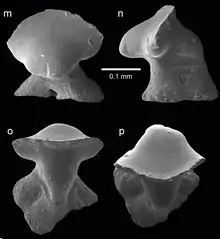| Antiquaobatis Temporal range: Late Pliensbachian | |
|---|---|
 | |
| Holotype tooth | |
| Scientific classification | |
| Domain: | Eukaryota |
| Kingdom: | Animalia |
| Phylum: | Chordata |
| Class: | Chondrichthyes |
| Subclass: | Elasmobranchii |
| Superorder: | Batoidea |
| Order: | Rajiformes |
| Genus: | †Antiquaobatis Stumpf & Kriwet, 2019 |
| Species: | †A. grimmenensis |
| Binomial name | |
| †Antiquaobatis grimmenensis Stumpf & Kriwet, 2019 | |
Antiquaobatis is an extinct genus of ray from the Early Jurassic (Late Pliensbachian) of Europe, containing the single species A. grimmenensis. It is the oldest known described member of the Rajiformes, and is based on a single tooth from Pliensbachian of Northern Germany.[1] It was recovered from the Grimmen Clay Pit, on Spinatum strata that belongs in the region to the Komorowo Formation.[2] The holotype is a single antero-lateral tooth, very small and slightly asymmetrical, measuring 0.25 mm in maximum height and 0.26 mm in maximum width, that has an overall morphology, that suggests a consistent referral to Batoidea, encompassing all skates and rays.[1] The tooth has an overall rather gracile crown morphology, different from any other know jurassic batomorphs, indicating closest affinities to the monotypic genus Engaibatis schultzei from the Kimmeridgian-Tithonian of Tanzania.[1]
Paleoenvironment
The Late Pliensbachian level of the Grimmen clay pit was trougth to be part of the Allenstein (Komorowo Formation), but due to be composed by sandstones there was a strong disagreement linking the fluvial Olsztyn with Germany, as comes from the Mazury area -easternmost part of the Polish basin and there is no link with the local Amaltheenton Beds, unlike the Komorowo Formation.[2] The described tooth of Antiquaobatis is considered to come from allochthonous origin, as it has suffered massively from post-mortem breakage in many cases, most probably due to extensive reworking and redistribution generated by current activities.[1] This taxon probably lived on the marine areas that were located in closer proximity to the Fennoscandian mainland, such as the paralic depositional environments of the Sorthat Formation of Bornholm, Denmark.[3] But also can have been moved from the Polish Basin, as on the deposition of this Tooth it was flooded by the sea, as proven by the find on ammonites on central Poland.[4]
A Nectobenthic lifestyle has been suggested for Jurassic batomorphs, specially complete taxa such as Belemnobatis and Spathobatis, that are superficially similar to extant members of which are generally characterized by sharing a bauplan similar to extant Rhinobatidae, adapted to eat hard-shelled prey.[1][5] Antiquaobatis grimmenensis appears to have used different, less specialized and probably more opportunistic feeding strategies, as suggested by the gracile and high tooth morphology.[1]
References
- 1 2 3 4 5 6 Sebastian Stumpf; Jürgen Kriwet (2019). "A new Pliensbachian elasmobranch (Vertebrata, Chondrichthyes) assemblage from Europe, and its contribution to the understanding of late Early Jurassic elasmobranch diversity and distributional patterns". PalZ. 93 (4): 637–658. doi:10.1007/s12542-019-00451-4.
- 1 2 Menning, M.; Pieńkowski, G.; Käding, K. C.; Maletz, J.; Kemnitz, H.; Kramer, W.; Hiß, M. (2020). "Korrekturen und Ergänzungen zur Stratigraphischen Tabelle von Deutschland 2016 (STD 2016)". Zeitschrift der Deutschen Gesellschaft für Geowissenschaften. 1 (1): 1–35.
- ↑ Michelsen, O.; Nielsen, L. H.; Johannessen, P. N.; Andsbjerg, J.; Surlyk, F. (2003). "Jurassic lithostratigraphy and stratigraphic development onshore and offshore Denmark". Geological Survey of Denmark and Greenland (GEUS) Bulletin. 1 (1): 145–216. doi:10.34194/geusb.v1.4651. S2CID 126907584.
- ↑ Barth, G.; Pieńkowski, G.; Zimmermann, J.; Franz, M.; Kuhlmann, G. (2018). "Palaeogeographical evolution of the Lower Jurassic: high-resolution biostratigraphy and sequence stratigraphy in the Central European Basin". Geological Society, London, Special Publications. 469 (1): 341–369. Bibcode:2018GSLSP.469..341B. doi:10.1144/SP469.8. S2CID 134043668. Retrieved 8 September 2021.
- ↑ Delsate, D.; Candoni, L. (2001). "Description de nouveaux morphotypes dentaires de Batomorphii toarciens (Jurassique inférieur) du Bassin de Paris: Archaeobatidae nov. fam". Bulletin-Société des Naturalistes Luxembourgeois. 102 (1): 131–143. Retrieved 19 November 2021.